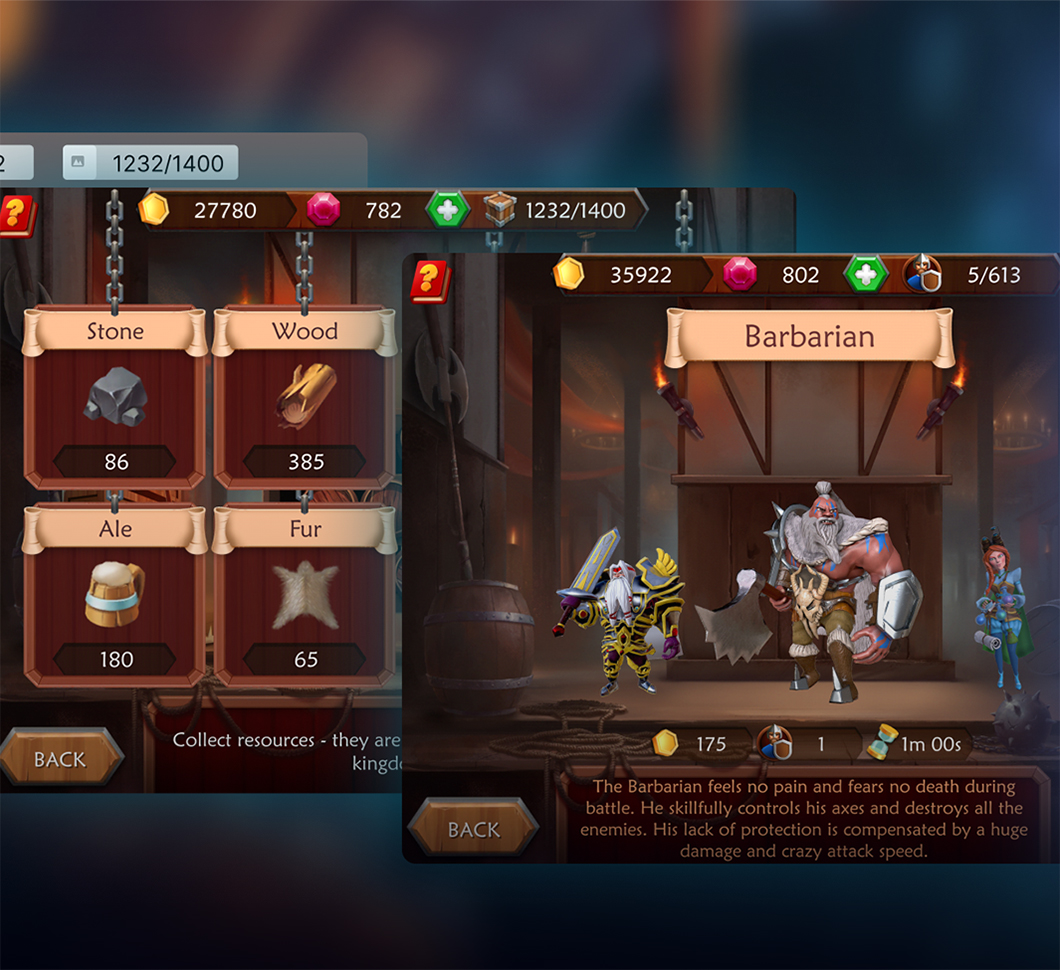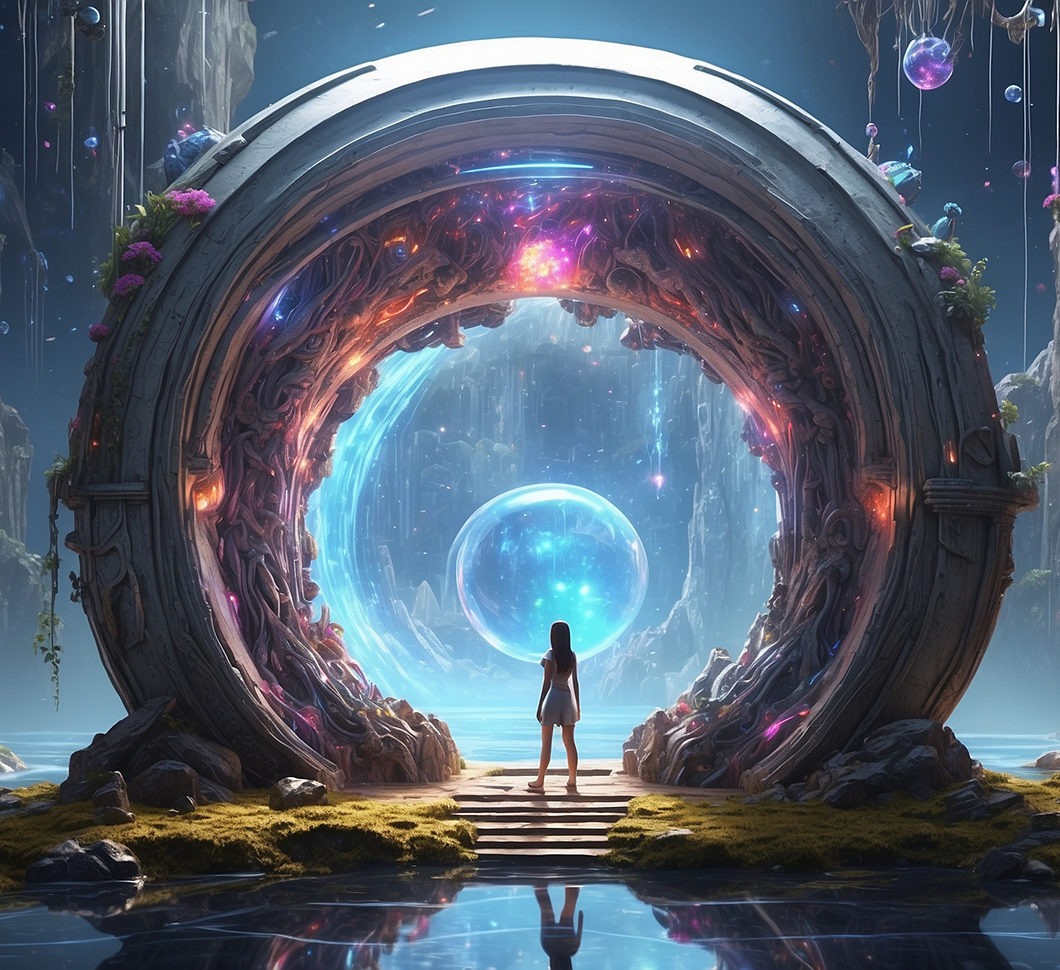In their quest to develop a best-selling game, many studios craft a compelling pitch — an element of the project designed to astonish and mesmerize their audience. Their attention is commonly directed toward aspects such as the narrative, visually appealing graphics, and intricate animations. While these elements are undeniably crucial and can significantly influence a game's success or failure, a notable oversight in many studios is the underutilization of immersive technology and the remarkable enhancements it can introduce to a gaming title.
Our mission is to elucidate the comprehensive scope of immersive game design and its integration into full-cycle game development. Immersive game design represents more than an additional feature; it embodies a transformative method that redefines the gaming experience. Such a design philosophy involves integrating state-of-the-art virtual technology, aiming to create an immersive game environment that not only engrosses players but also immerses them in the game's virtual world in a manner that is both authentic and captivating.
Integrating immersive gaming elements into a project demands a delicate balance between technological innovation and creative vision. The goal is to ensure that the virtual environment is convincing, interactive, and responsive to player interactions. This is the core of immersive gaming — leveraging virtual reality, augmented reality, and other immersive technologies to construct experiences that transcend traditional gaming, offering players games and virtual tours into novel and uncharted territories.
What is Immersive Game Design?
From a technical standpoint, immersive games are those built using immersive technologies like AR and VR. They take the first-person principle of games to another level and use the physical surroundings of a user as the backdrop for the game, or completely replace the physical world with a digital one, covering most of a user’s senses.
Of course, you could also make the argument that immersion is a characteristic present in games on other platforms (PC, console, etc.) and simply means how well a game captivates and interests players. This is true, but this article will mostly examine games that are immersive from a tech standpoint.
Making immersive games for augmented and virtual reality comes with a broad set of challenges, and we hope this guide will make the process smoother for any company that chooses this path.
What Is Immersive Gaming?
Immersive gaming represents the pinnacle of interactive entertainment, offering a gaming experience that profoundly engages players mentally and emotionally. This form of gaming is distinguished by its ability to seamlessly merge the virtual environment with reality, intensifying the overall experience and making it feel more lifelike.
The essence of immersive gaming lies in its technological foundation, particularly the integration of advanced XR technologies like virtual reality, augmented reality, and 3D audio. Almost every virtual reality game development company utilizes these technologies to:
- Create a game immersive environment. Crafting a space where players feel genuinely a part of the game's universe.
- Enhance player interaction. Using VR headsets to transport players into a fully virtual world or AR to add digital elements to the real world.
A crucial aspect of immersive gaming is immersive game design, which focuses on engaging the player through:
- Detailed virtual worlds. Building environments that are rich in detail and invite exploration.
- Responsive game mechanics. Designing interactions that adapt to players' choices ensures a unique session experience.
Immersive gaming is about emotional involvement, not just technology and design. These games provoke a broad range of feelings, including excitement, pleasure, terror, and empathy, making the gaming experience more memorable and meaningful. This emotional connection is crucial for producing a really immersive experience.
Therefore, immersive gaming is set to revolutionize the industry. With continuous advancements in technology and immersive game design, this genre is evolving beyond traditional gaming, offering players not just a game but a comprehensive world to experience.
Immersive game design aims to establish profound player immersion. This is done by blending visually gorgeous visuals, fascinating storytelling, and interactive gameplay that reacts dynamically to the player's actions, immersing them entirely in the game universe.
Why Is Immersive Gaming Important?
Immersive gaming has emerged as a critical aspect of the gaming industry, reshaping how players interact with and perceive games. This importance stems from several factors that enhance the gaming experience and push the boundaries of technology and storytelling.
Fundamentally, immersive game design is critical to the advancement of gaming technology. When it comes to each individual augmented reality game development company, game immersion is being built differently, yet they all share a single purpose — to give players a true sensation of being 'within' the game. This technological leap forward represents a significant milestone in gaming, offering experiences far beyond traditional screen-based games.
Moreover, immersive gaming fosters a deeper emotional connection between the game and the player. The immersive nature of these games allows for more profound narrative experiences where players feel an integral part of the story. This heightened emotional engagement makes the gaming experience more impactful and memorable, a feature increasingly sought after in modern gaming.
Another crucial aspect of immersive gaming is its ability to enhance cognitive skills. Players engaged in immersive environments often experience improved problem-solving skills, heightened attention to detail, and better spatial awareness. These benefits extend beyond the game, impacting real-world skills and abilities.
The influence of immersive gaming also extends to its social impact. Multiplayer immersive games create virtual communities, allowing social interactions that transcend geographical boundaries. This aspect of gaming fosters global connections and cultural exchange, making immersive gaming a unifying experience for diverse groups of people.
Finally, immersive gaming is pivotal in driving innovation within the gaming industry. Immersive game design challenges developers to continually push the limits of what is possible, leading to groundbreaking advancements in gaming technology and storytelling. As a result, the gaming industry continues to evolve, offering ever-more sophisticated and engaging experiences to players worldwide.
Overall, immersive gaming holds significant importance in today's gaming landscape. Its impact on technology, emotional engagement, cognitive development, social interaction, and industry innovation underscores its value and the reason it continues to captivate the attention of players and developers alike.
What Makes a Video Game Immersive?
When designing a game, several vital considerations are essential to ensure compatibility with the intended platform while keeping players engaged and invested over time:
- Graphic immersionAR and VR technologies bring unparalleled graphic immersion, setting them apart from other platforms. AR creates this effect by scanning the player's surroundings using the device's camera. Even when digital models and objects integrate with these real-world visuals, the player retains a sense of familiarity with the game's setting. Conversely, VR offers an entirely immersive graphic experience through a headset that replaces the user's field of view with a virtual environment, enveloping them in a completely different world.
- Audio immersionThe strategic use of sound and music significantly enhances the immersive gaming experience, making it more realistic and engaging. Music sets the tone, evoking emotions and preparing the player's mindset for the journey ahead. Sounds, like the subtle snap of a twig, can be amplified or softened to evoke emotional responses like fear or relief and provide clues about the game's environment, enhancing the sense of being stalked or the proximity of danger.
- StorytellingIn today's immersive gaming philosophy, exceptional storytelling can compensate for a game's shortcomings or amplify its strengths. Crafting unique and captivating stories is increasingly challenging, but the payoff is significant. Players are attracted to intricate, believable worlds, nuanced characters, and plots filled with surprises. A well-executed narrative substantially increases the likelihood of a game's success and ability to generate excitement.
- ActingWhile many games don't use motion-captured actors or live footage, realistic voice acting can enhance character believability. Reading text dialogs differs from hearing characters express emotions and intentions through their voices. This addition brings characters to life and adds depth and realism to the game's world, contributing to the overall immersive experience.
Essential Elements of Immersive Gaming
Understanding the key elements contributing to immersive gaming is crucial in addressing "What Makes a Video Game Immersive?" These components are vital in crafting an experience that profoundly engages players, making each gaming session an unforgettable journey into virtual realms.
Engaging storytelling. Storytelling is pivotal in immersive game design. A compelling narrative with intricate characters and detailed worlds transforms players from mere observers to active participants, deeply embedded in the game's unfolding story.
Advanced graphics and visual design. The visual aspect of immersive gaming, with high-quality, detailed graphics, plays a significant role. Realistic environments, characters, and seamless animations enhance the game's immersive quality.
Dynamic soundscapes. Sound is critical in immersive gaming. It creates an auditory landscape that complements the visuals, transporting players deeper into the game's environment and enhancing immersion.
Interactive and responsive gameplay. Immersive game design features gameplay that reacts and evolves based on player actions, making each experience unique and increasing investment in the game's outcome.
Innovative use of technology. Technologies like VR and AR are essential in immersive gaming, breaking down barriers between the player and the game for a more intimate experience.
Emotional connection and player agency. A key aspect of what makes a game immersive is its ability to evoke emotions and provide players with a sense of agency, elevating engagement and deepening immersion.
These harmoniously integrated elements form the backbone of immersive gaming, defining experiences that are not just played but lived. Each aspect, from narrative to technology, creates a captivating, engaging, and immersive gaming environment.
Top Practices for Immersive Game Level Design
When enhancing the levels of your immersive gaming project, it's essential to leverage the strengths of the technology you're working with while maintaining a focus on user interest and engagement. Here are some strategies to consider:
- Prioritize thorough preparationEffective immersive game design begins well before development. If an innovative mechanic arises mid-development, it might be challenging to integrate it with your game's existing physics and mechanics. Therefore, it's advisable to draft a comprehensive game design document beforehand, detailing all intended goals and implementation strategies.
- Establish clear objectives and rewardsA sense of progression and purpose is crucial for players. In a combat-focused game, players expect increasingly challenging enemies and climactic boss battles. Regardless of genre, ensure players feel their actions contribute to a larger goal. Motivating players with rewards like enhanced weaponry can significantly impact their gaming experience.
- Incorporate breaks and interludesContinuous action and a linear narrative can become overwhelming. Introducing periods of downtime, where players can explore, discover new items, or interact with secondary characters, can add variety to the gameplay and provide a welcome respite. These breaks allow players to relax and prepare for upcoming, more demanding challenges.
- Design a realistic user point of view (POV)It is paramount to capture players' attention and immerse them in the game. While a third-person view may feel like mere character control, a first-person perspective can create a more immersive experience. Enhancing engagement in a first-person view involves adding detailed, realistic elements, such as nuanced shadow play and dynamic water movement, to convince players of the game's authenticity.
- Integrate diverse maps and sceneryWhile adding numerous maps might be challenging under tight development schedules, incorporating varied scenery and unique play areas can keep the immersive gaming experience fresh. It's crucial to balance the novelty of new environments with avoiding repetitiveness.
- Include enjoyable extrasWIncorporating easter eggs, puzzles, and bonuses can delight players and add an element of surprise. These unexpected discoveries, which players might share with friends, can significantly enhance the immersive gaming experience. Devoting time to these small but impactful details can greatly enrich the player's experience and is often appreciated.
By focusing on these aspects of immersive game design, developers can create a more engaging and immersive experience, ensuring that players remain captivated and invested in the gaming journey.

Are Immersion Strategies Different in VR and AR?
While augmented and virtual reality both fall in the category of xR (extended reality) technology, the differences in the mechanics they offer to users are vast. Accordingly, the design process for each technology should prioritize different things. Let’s take a look at the key differences:
| AR Design | VR Design | |
| Player location | AR games can be enjoyed anywhere and benefit from high user mobility. Additionally, the software can be built to take advantage of location services and visual markers, so players can move around (outside or inside) and scan real-world objects to get the full game experience. | VR games are not meant to be played everywhere, and require that the user stand (or sit) in a spot with a relatively small radius. Most VR headsets also require an electric socket to work, so the software should be designed with the assumption that the user will play in just one spot and not move around much. |
| Movement and interactions | Movement in AR apps can be divided into two categories: 1) gestures on the screen of the mobile device (taps, swipes, etc.) and 2) gestures that the device camera captures. As a rule, tracking movement with a camera and incorporating it into gameplay is a much better immersive tactic. | VR software registers movement through changes in headset orientation and special controllers (in some cases, gloves). This equipment provides a much more realistic and advanced tracking system than AR, and allows you to implement more complex and realistic mechanics (e.g. holding a rifle and pulling the trigger, using a three-finger gesture, etc.). |
| Play Time | While designing for AR, you have to keep in mind that most users will access the software through their smartphone, and likely during short breaks when they have free time. Thus, it is recommended to make most game interactions short (within the span of a few minutes). | There is a certain amount of preparation needed to enjoy a VR experience, so most layers that fire up a game like this will be able to dedicate substantial time to the experience. Thus, you can easily design levels and objectives that take hours to complete. |
| Collaboration | Augmented reality allows for the provision of several variants of multiplayer. For example, the application can be designed for 2 or more players to play on a single device. As another option, users can each play with one device but the game experience will be influenced by other people (e.g. gym battles in Pokemon Go). | Adding multiplayer in VR can be tricky, since most existing games are meant for solo play. Still, it is possible to make a game that will feature two players (each with their own headset). One alternative is for players to connect online with other people using headsets, such as in the highly popular VRChat app (where people with digital avatars meet in virtual rooms just to chat). |
| User safety | It is incredibly important to implement safety guidelines in AR apps, such as warnings and restrictions. When people get too captivated by a game, they can stop paying attention to their surroundings and fall prey to hazards. If it is not feasible to make your app recognize these hazards, it is recommended to at least add warnings for the user’s safety. | Unless your application involves a lot of walking (which is not a good idea with blocked vision), players will likely be confined to a small play area. You can let them know that they should choose this area wisely, and remove any impediments or objects that could cause them harm during movement. Additionally, in-game movement should be smooth so as not to induce motion sickness. |
Best Immersive Game Examples
Augmented reality apps have been in public use for about a decade (VR for longer), and though the technology is fledging, we have already seen some great games arise both in the AR and VR categories:
- Beat Saber
 This best-selling VR game combines two things that most people love – lightsabers and music. In Beat Saber, the player is placed in a dimly lit world where blocks and obstacles fly towards them to the beats of songs. The gameplay is very dynamic and immersive, as they slice and evade the blocks to survive.
This best-selling VR game combines two things that most people love – lightsabers and music. In Beat Saber, the player is placed in a dimly lit world where blocks and obstacles fly towards them to the beats of songs. The gameplay is very dynamic and immersive, as they slice and evade the blocks to survive. - Half Life: Alyx
 Before Alyx came out, people had been waiting years for a Half-Life sequel, and this one did not disappoint. Players put on their VR headsets and returned to the dangerous and rich world of Half-Life, fighting numerous enemies and progressing the story of Alyx, the main protagonist.
Before Alyx came out, people had been waiting years for a Half-Life sequel, and this one did not disappoint. Players put on their VR headsets and returned to the dangerous and rich world of Half-Life, fighting numerous enemies and progressing the story of Alyx, the main protagonist. - No Man’s Sky
 This game was initially released for PC and console play, but grew so popular that it was ported to VR. To say that the game is immersive would be an understatement. You play as a spacefaring scientist, traveling to hundreds (even thousands) of unique planets, colonizing and documenting everything that makes them unique.
This game was initially released for PC and console play, but grew so popular that it was ported to VR. To say that the game is immersive would be an understatement. You play as a spacefaring scientist, traveling to hundreds (even thousands) of unique planets, colonizing and documenting everything that makes them unique. - ARchy the Rabbit
 ARchy was designed by Game-Ace and features a playful 3D rabbit character that players control. As the name suggests, this is an AR app, so it can be accessed on mobile devices. After the app is launched, players can see Archy visualized in their current surroundings, and enjoy watching him carry out the entertaining commands.
ARchy was designed by Game-Ace and features a playful 3D rabbit character that players control. As the name suggests, this is an AR app, so it can be accessed on mobile devices. After the app is launched, players can see Archy visualized in their current surroundings, and enjoy watching him carry out the entertaining commands. - Ingress
 Ingress is the elder statesman of AR games, being released in 2013 when the technology was brand new. It draws users into a world of factions and battles for resources. Players must move around the physical world (based on real maps), capture portals, and increase their XP.
Ingress is the elder statesman of AR games, being released in 2013 when the technology was brand new. It draws users into a world of factions and battles for resources. Players must move around the physical world (based on real maps), capture portals, and increase their XP.
How to Start Designing an Immersive Game

If you have not developed a game before or built one for AR/VR, our custom game development company should warn you that there will be a lot to learn before you even start writing code or creating 3D models. You will need to get acquainted with the basic principles of immersive development, as well as the peculiarities of working with AR/VR-specific software, like ARKit, ARCore, Vuforia, and possibly Unity/Unreal Engine.
As an alternative to painstaking independent learning and development, you can consider delegating design to a partner. For example, Game-Ace has years of experience in creating games for various platforms, including VR and AR. We are the studio behind the game ARchy the Rabbit mentioned previously and dozens of other titles with major player bases.
You can count on us to make a game that will draw users in not just based on technology, but also smart level design and spectacular graphics. Additionally, we can handle game porting and art design as services separate or included with development.
Ready to discuss your game project? Contact us and we can help!
 This best-selling VR game combines two things that most people love – lightsabers and music. In Beat Saber, the player is placed in a dimly lit world where blocks and obstacles fly towards them to the beats of songs. The gameplay is very dynamic and immersive, as they slice and evade the blocks to survive.
This best-selling VR game combines two things that most people love – lightsabers and music. In Beat Saber, the player is placed in a dimly lit world where blocks and obstacles fly towards them to the beats of songs. The gameplay is very dynamic and immersive, as they slice and evade the blocks to survive. Before Alyx came out, people had been waiting years for a Half-Life sequel, and this one did not disappoint. Players put on their VR headsets and returned to the dangerous and rich world of Half-Life, fighting numerous enemies and progressing the story of Alyx, the main protagonist.
Before Alyx came out, people had been waiting years for a Half-Life sequel, and this one did not disappoint. Players put on their VR headsets and returned to the dangerous and rich world of Half-Life, fighting numerous enemies and progressing the story of Alyx, the main protagonist. This game was initially released for PC and console play, but grew so popular that it was
This game was initially released for PC and console play, but grew so popular that it was  ARchy was designed by Game-Ace and features a playful 3D rabbit character that players control. As the name suggests, this is an AR app, so it can be accessed on mobile devices. After the app is launched, players can see Archy visualized in their current surroundings, and enjoy watching him carry out the entertaining commands.
ARchy was designed by Game-Ace and features a playful 3D rabbit character that players control. As the name suggests, this is an AR app, so it can be accessed on mobile devices. After the app is launched, players can see Archy visualized in their current surroundings, and enjoy watching him carry out the entertaining commands. Ingress is the elder statesman of AR games, being released in 2013 when the technology was brand new. It draws users into a world of factions and battles for resources. Players must move around the physical world (based on real maps), capture portals, and increase their XP.
Ingress is the elder statesman of AR games, being released in 2013 when the technology was brand new. It draws users into a world of factions and battles for resources. Players must move around the physical world (based on real maps), capture portals, and increase their XP. Mastering Narrative Game Design for Unforgettable Player Experiences
Mastering Narrative Game Design for Unforgettable Player Experiences  What Is Game UX? The Complete Guide for 2024
What Is Game UX? The Complete Guide for 2024  The Role of AR In Games Described and Explained
The Role of AR In Games Described and Explained  How Can Different Video Game Art Styles Enhance Your Project?
How Can Different Video Game Art Styles Enhance Your Project?  How Much Does It Cost to Make a Video Game in Real-World Conditions?
How Much Does It Cost to Make a Video Game in Real-World Conditions? 
























